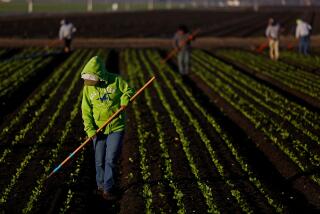240,000 Americans Left the Land in ’87 : More Give Up Farm Life, Report Says
- Share via
WASHINGTON — An estimated 240,000 people left life on the farm last year, dropping the nation’s farm population to the lowest level since before the Civil War, the government reported Tuesday.
Officials said an average of 4,986,000 people--one out of every 49 Americans--lived on farms in 1987, representing 2% of the U.S. population of 243.4 million.
That compared to 5,226,000 farm residents in 1986, which was 2.2% of the national population of 241.1 million.
The figures were derived from an annual survey by the Census Bureau, an agency of the Commerce Department, and released jointly with the Agriculture Department. A preliminary report was issued Feb. 8.
Although the 1987 farm population estimate was down by 240,000 people, the report said that represented “no statistically significant change” from 1986. The one-year decline would have had to have been at least 275,000 for that, the report said.
From 1981 through 1987, the farm population has lost an average of 2.5% annually, the report said. In the previous decade, the annual decline averaged 2.9%.
The report said the 1920 census is regarded as the beginning of the government’s official nose count of the farm population, although estimates go back much earlier.
In one of the tables, for example, figures on the number of Americans in “farm occupations” go back to 1820, when farmers were reported at less than 2.1 million, making up about 72% of the U.S. work force of 2.9 million.
By 1850, farmers made up 4.9 million, or about 64% of the nation’s 7.7 million workers.
The farm population in 1920, when the official Census data began, was nearly 32 million, or 30.2% of the U.S. population of 105.7 million, the report showed.
According to USDA estimates going back to 1910, however, the farm population peaked at 32.5 million people in 1916 during World War I, making up 32% of the population of 101.6 million.
Despite a general downward trend since World War I, the farm population has had a few short-lived surges, including one during the Great Depression when it grew to 31.2 million in 1933, making up 24.9% of the U.S. population of 125.4 million that year.
Another slight bulge appeared in 1983 as thousands shifted from city living to the countryside, raising the farm population to more than 7 million from 6.88 million in 1982.
Some other observations included in the 1987 farm population report:
- Half of the total farm population lives in the Midwest. The South has 29%; the West, 15%, and the Northeast, 6%. Officials said reliable state and local farm population figures were not available.
At mid-century, about a third of all farm people lived in the Midwest, while slightly more than half were in the South. A rapid decline of the South’s farm population, rather than any growth in the Midwest, led to the shift.
- As compared to the non-farm population, the farm population has a higher proportion of whites, 97%. Blacks are 2.5% of the farm population and “other” races, 0.6%. Those are approximate figures.
Hispanics made up 2.7% of the farm population, the report said.
Comparatively, the U.S. non-farm population last year was 84.4% white, 12.3% black, and 3.3% other races, the Census Bureau said. Hispanics made up 8.1% of the total.
- The median age of farm residents was 37.6 years in 1987, which “is significantly higher” than the non-farm median of 32 years. That means half of the farm people were older, half younger than the median age.
“In the 1920 census, when data on the farm population were first collected, their median age was 20.7 years, lower than the medians for the rural total and the urban population,” the report said.
- Last year, there were 109 males per 100 females living on farms, compared to just 93 males per 100 females in the non-farm population. In 1920, the farm ratio was the same, while the non-farm ratio was 102 males per 100 females.
More to Read
Sign up for Essential California
The most important California stories and recommendations in your inbox every morning.
You may occasionally receive promotional content from the Los Angeles Times.









